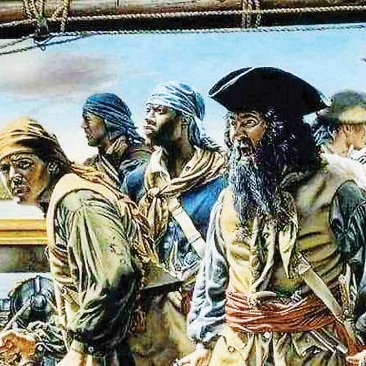
News

History unearths Jewish piracy as revenge for the Spanish Inquisition
JORDAN MOSHE
As European nations advanced westward in a scramble for colonies, the Caribbean became prime property for pirates, among them Jews.
Taking to the high seas aboard the Queen Esther, the Prophet Samuel or even the Shield of Abraham, a rich history is gradually coming to light of Jewish buccaneers who undermined the Inquisition and persecution by becoming pirates.
Between the 1600s and 1800s, Jews fleeing persecution at the hands of Catholic Europe often joined the voyages of explorers bound for South America and the Caribbean. Out of this fateful encounter of piracy and Judaism, many Jews took up swashbuckling lives on the high seas.
While history books have rarely accounted for the exploits of Jewish pirates, their surprising prevalence has gained more recognition in recent years. They even feature in a book titled Jewish Pirates of the Caribbean by Edward Kritzler.
Excavations carried out in historical graveyards discovered in the Caribbean over the past decade have yielded tombstones featuring a combination of the Magen David, Hebrew writing, and the infamous skull and crossbones insignia.
Though certain Jewish pirates of antiquity – most notably those of the Hasmonean period – have been accounted for, most were active after the Spanish expulsion of the Jews in 1492.
Exacting revenge on the Catholic empire, they frequently seized control of its trading vessels, often with the backing of their new refuge, including the Ottoman Empire or Europe’s Spanish rivals such as the United Netherlands.
Dozens of Jews were also economically invested in backing privateers attacking Spanish ships. Privateers were essentially pirates with government protection for the pursuit of less-than-legal goals in wealth, dominance, and control of the seas. Jewish privateers could have seen it as a profitable revenge strategy for the expulsion and continued religious persecution of Jews.
Even the Caribbean, the very capital of piracy, served as a welcome haven for Jewish buccaneers. Jamaica was one among the many remote and distant locales in the New World where Jews and other unwelcome apostates sought shelter as far from the inquisitors of Spain and Portugal as possible.
The lush Caribbean island served as home to several hundred Jews. While many of them sought to make a living from typical economic opportunities like sugarcane plantations or by trading various commodities, others turned to a more adventurous calling: a pirate’s life at sea
As Kritzler suggests, perhaps the most famous of the Caribbean’s Jewish pirates was Moses Cohen Henriques. After living initially as a secret Jew under the inquisition in his native Portugal, he was discovered in 1605, and tortured in public.
The experience is said to have led Cohen to devote his life to working against Spain and Portugal. Escaping to Amsterdam, he reportedly enlisted as a secret agent for the Dutch navy, making his way to Jamaica. On behalf of the Netherlands, he attacked Spanish ships, and frustrated Spain’s plans to settle the New World.
Teaming up with Dutch hero Admiral Piet Pieterszoon Hein and one of the most feared pirates, Sir Henry Morgan, Henriques went on to capture vessels across the sea. His prizes included a legendary treasure fleet, consisting of a fortune of gold and silver bullion that amounted to a staggering 11 509 524 guilders (worth around $1 billion or R14.4 billion today). It was hailed as the Dutch West India Company’s greatest heist in the Caribbean.
Another recorded Jewish pirate was Yaakov Koriel, who commanded three pirate ships in the Caribbean. He eventually renounced his piracy, and retired to the Israeli city of Tzfat, studying mysticism under famed Kabbalist Rabbi Isaac Luria. Another is David Abrabanel, who joined British privateers after his family was put to death off the South American coast. He assumed the name “Captain Davis”, and commanded his own pirate vessel called Jerusalem.
All of Spanish extraction, Henriques, Koriel, and Abrabanel knew too well the sting of the anti-Semitic slur marrano (pig) and its associated acts of persecution.
Although he was French, their cousin from across the pond, Jean Lafitte, knew the meaning of maudit juif (damned Jew), and similarly turned to piracy to take revenge for persecution.
Born in France in about 1780, the infamous buccaneer moved to the French colony of New Orleans in the United States, where he and his brother, Pierre, held respectable jobs as blacksmiths.
Unbeknown to anyone else, however, they held commissions from the Republic of Cartagena (found in today’s Colombia) to intercept Spanish boats. With a crew and ships of their own, they carried out raids off the coast of New Orleans from a secluded colony in Barataria Bay.
Laffite offered his services to General Andrew Jackson in 1812 to help American troops foil British invasion plans in exchange for a pardon of pirate activities. Jackson agreed, and Laffite’s gang emerged victorious. Jackson would later dub Laffite “one of the ablest men” of the Battle of New Orleans.
A pirate to his core, however, Laffite returned to piracy a few years later, amassing almost a thousand followers. Until his death in about 1825, Laffite maintained his reputation as a feared pirate of the “Spanish Main”, the eastern coast of Spain’s holdings in the New World.
As several other such accounts come to light, the range of Jews who took up a life on the high seas continues to grow. A Moroccan rabbi, the right-hand man of famed Turkish pirate Barbarossa, and even a physician credited with introducing the potato to Europeans are among the Jewish figures emerging as having held a life of piracy.
Whether they substituted the cry of “Yo ho ho!” with “Oy vey!” we may never know, but their stories are undoubtedly as impressive as any other found in the annuls of piracy’s history.




